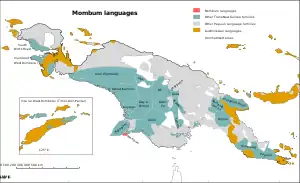Mombum languages
The Mombum languages, also known as the Komolom or Muli Strait languages, are a pair of Trans–New Guinea languages, Mombum (Komolom) and Koneraw, spoken on Komolom Island just off Yos Sudarso Island, and on the southern coast of Yos Sudarso Island, respectively, on the southern coast of New Guinea. Komolom Island is at the southern end of the Muli Strait.[1]
| Mombum | |
|---|---|
| Komolom Muli Strait | |
| Geographic distribution | Komolom Island, southern New Guinea |
| Linguistic classification | Trans–New Guinea
|
| Glottolog | momb1255 |
 Map: The Mombum languages of New Guinea
The Mombum languages
Other Trans–New Guinea languages
Other Papuan languages
Austronesian languages
Uninhabited | |
History of classification
Mombum was first classified as a branch isolate of the Central and South New Guinea languages in Stephen Wurm's 1975 expansion for Trans–New Guinea, a position tentatively maintained by Malcolm Ross, though he cannot tell if the similarities are shared innovations or retentions from proto-TNG. Usher instead links them to the Asmat languages.[1] Koneraw is clearly related to Mombum, but was overlooked by early classifications. Along with the Kolopom languages, they are the languages spoken on Yos Sudarso Island (Kolopom Island).
Noting insufficient evidence, Pawley and Hammarström (2018), who refer to the languages as the Komolom branch, tentatively leave it as unclassified rather than as part of Trans-New Guinea.[2]
Pronouns
Pronouns are:
sg pl 1 *nu *nu-mu, *ni 2 *yu *yu-mu 3 *eu
Vocabulary comparison
The following basic vocabulary words are from McElhanon & Voorhoeve (1970)[3] and Voorhoeve (1975),[4] as cited in the Trans-New Guinea database:[5]
gloss Koneraw Mombum head wonderam wondrum hair cin xu-sin eye dyan musax-nam tooth cire zix leg kan kaŋk louse am am dog ubui ipwi pig u u bird baŋa konji egg yausil blood iri iri bone iŋar itöx skin par par tree to tu man nam nam sun dzuwo zawa water mui mwe fire war wad stone mate mete name ur ur eat gim-nugu nuku- one tenamotere te two kuinam kumb
References
- New Guinea World, Muli Strait
- Pawley, Andrew; Hammarström, Harald (2018). "The Trans New Guinea family". In Palmer, Bill (ed.). The Languages and Linguistics of the New Guinea Area: A Comprehensive Guide. The World of Linguistics. 4. Berlin: De Gruyter Mouton. pp. 21–196. ISBN 978-3-11-028642-7.
- McElhanon, K.A. and Voorhoeve, C.L. The Trans-New Guinea Phylum: Explorations in deep-level genetic relationships. B-16, vi + 112 pages. Pacific Linguistics, The Australian National University, 1970. doi:10.15144/PL-B16
- Voorhoeve, C.L. Languages of Irian Jaya: Checklist. Preliminary classification, language maps, wordlists. B-31, iv + 133 pages. Pacific Linguistics, The Australian National University, 1975. doi:10.15144/PL-B31
- Greenhill, Simon (2016). "TransNewGuinea.org - database of the languages of New Guinea". Retrieved 2020-11-05.
- Ross, Malcolm (2005). "Pronouns as a preliminary diagnostic for grouping Papuan languages". In Andrew Pawley; Robert Attenborough; Robin Hide; Jack Golson (eds.). Papuan pasts: cultural, linguistic and biological histories of Papuan-speaking peoples. Canberra: Pacific Linguistics. pp. 15–66. ISBN 0858835622. OCLC 67292782.